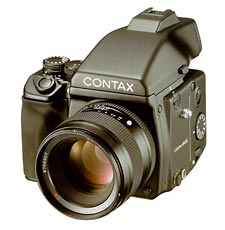

This camera is a breeze to use. Loading the film was about the only aspect of this camera
that felt unfamiliar, and this was made fairly simple by the explicit and well illustrated
instruction manual, as well as the reminder graphic printed inside the film holder.
The autofocus works reasonably well, albeit not as quickly as my 35mm SLRs. At a family
wedding I was recently photographing, I found that the autofocus would often hunt in lower
lighting situations. It is trivial to override the autofocus by simply turning the focus
dial (no switches). There is also a convenient button right under your right thumb that
locks the focus. A switch is also provided to turn autofocus off and to switch between
single shot and continuous focus tracking. The viewfinder also has a diopter adjustment
build in, making it easy to tune for your own eyesight.
The view through the finder is nice and bright. Illuminated viewfinder info includes the
aperture, shutter speed, frame number, focus indication, metering mode, exposure
compensation, and battery and flash status. There is no external LCD display as found on
many 35mm SLRs, although all this information is available on various dials. I would have
preferred to have this info centralized on an external display, however.
The built in motor drive worked fine for advancing to the first frame and completing the
film winding at the end of the roll, as well as advancing between frames. I haven't had an
opportunity to use the continuous motor drive. The camera is quieter than my Nikons, but a
little louder than my Canon A2E. A small dial on the upper left of the camera selects
between single shot, continuous, or 2 and 10 second time delays. As with my Canon, the
mirror locks up at the start of the timing cycles, making the 2 second mode ideal for
landscape shots on a tripod.
I ended up using aperture priority mode for most of the shots I took since it was easier
to turn the aperture dial while looking through the viewfinder than it was to turn the
shutter dial. It is a little hard to reach the exposure compensation dial when looking
through the viewfinder, but I'm sure I'll get used to that.
The depth of field preview worked great. The button to stop the lens down is located just
below and to the right of the lens while holding it up to your eye, so it can be engaged
easily by the right ring finger. The viewfinder was so bright that I found I still had
enough light to gage depth of field even when stopping fairly far down. I have not found
this to be the case with my 35mm SLRs.
The built in center weighted averaging and spot meter are both dead on
although obviously much less sophisticated than the matrix metering in the 35mm SLRs. It's
not a point and shoot, but with appropriate exposure compensation for backlighting, very
light or very dark scenes, it's pretty easy to get a good exposure. I've probably been
averaging one bad exposure (off more than a stop) for every two to three rolls of film
I've shot.
The camera feels fairly well balanced, and works well for hand held shots, although I did
find that I accidentally turned the motor drive dial to 2 second delay once which resulted
in a lost shot. On the tripod, the camera worked great aside from not having an external
LCD display. As expected, it was a little easier to take horizontal format images than
vertical.
The camera feels solid, but not too heavy. It is well finished in a matte black. There are
many parts that appear to be made from polycarbonate. Those that are used to all metal
cameras may be a little disappointed by this, but I've had great luck with my Canon SLRs
which also use polycarbonate extensively. Metal is used for both the lens and tripod
mounts - the two most delicate points on the camera.
The camera also has interchangeable backs and viewfinders. I ordered mine with the
standard 120/220 back and later added the vacuum back. A Polaroid back is also
available.
Focusing screens are also interchangeable, and I believe a waist level viewfinder is
available. The camera takes 32 exposures using the 220 back, and I assume 16 with the 120
back.
The camera also includes built in data imprinting. It records the shutter speed, aperture,
exposure compensation, exposure mode, type of lens and type of film (120/220) on the edge
of the film for every shot. Since I am too undisciplined to record this info on my own, I
find this an invaluable tool for understanding what I did wrong with the images that don't
turn out.
Along with the 80mm F2 lens that came with the camera package, I purchased a 35mm
F3.5 and a 210mm F4. All three lenses appear to be of extremely high quality. The aperture and focus dials
feel very smooth with no sloppy movement. I could see no geometric distortion in the wide angle
lens.